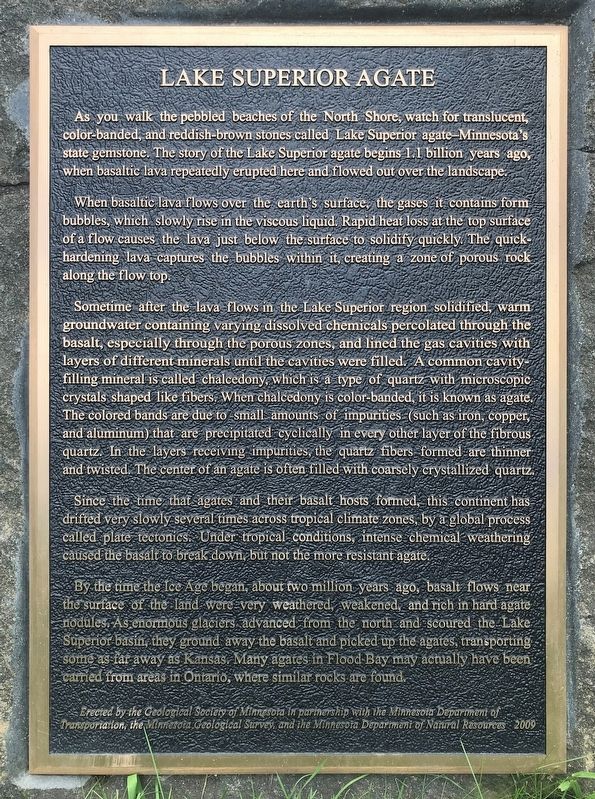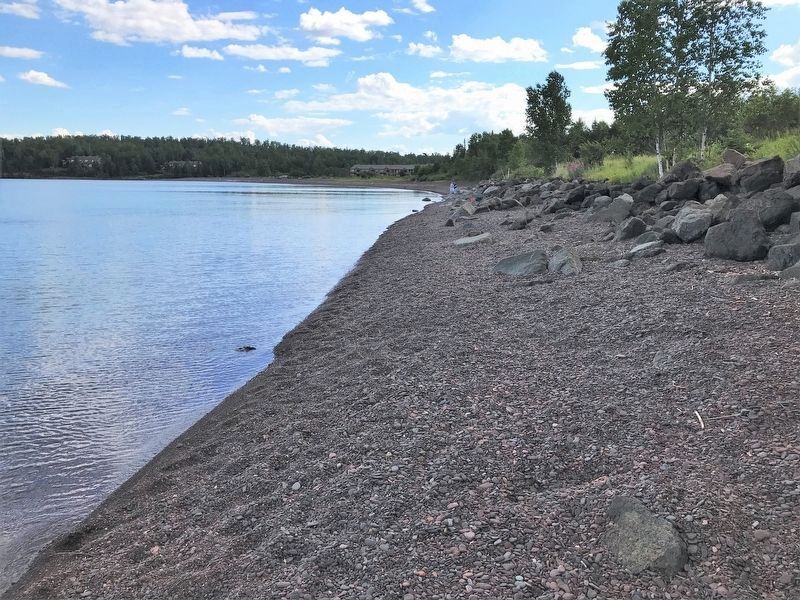Near Two Harbors in Lake County, Minnesota — The American Midwest (Upper Plains)
Lake Superior Agate
When basaltic lava flows over the earth's surface, the gases it contains form bubbles, which slowly rise in the viscous liquid. Rapid heat loss at the top surface of a flow causes the lava just below the surface to solidify quickly. The quick-hardening lava captures the bubbles within it, creating a zone of porous rock along the flow top.
Sometime after the lava flows in the Lake Superior region solidified, warm groundwater containing varying dissolved chemicals percolated through the basalt, especially through the porous zones, and lined the gas cavities with layers of different minerals until the cavities were filled. A common cavity-filling mineral is called chalcedony, which is a type of quartz with microscopic crystals shaped like fibers. When chalcedony is color-banded, it is known as agate. The colored bands are due to small amounts of impurities (such as iron, copper, and aluminum) that are precipitated cyclically in every other layer of the fibrous quartz. In the layers receiving impurities, the quartz fibers formed are thinner and twisted. The center of an agate is often filled with coarsely crystallized quartz.
Since the time that agates and their basalt hosts formed, this continent has drifted very slowly several times across tropical climate zones, by a global process called plate tectonics. Under tropical conditions, intense chemical weathering caused the basalt to break down, but not the more resistant agate.
By the time the Ice Age began, about two million years ago, basalt flows near the surface of the land were very weathered, weakened, and rich in hard agate nodules. As enormous glaciers advanced from the north and scoured the Lake Superior basin, they ground away the basalt and picked up the agates, transporting some as far away as Kansas. Many agates in Flood Bay may actually have been carried from areas in Ontario, where similar rocks are found.
Erected 2009 by the Geological Society of Minnesota in partnership with the Minnesota Department of Transportation, the Minnesota Geological Survey, and the Minnesota Department of Natural Resources.
Topics and series. This historical marker is listed in this topic list: Waterways & Vessels. In addition, it is included in the Minnesota: Geological Society of Minnesota series list.
Location. 47° 2.295′ N, 91° 38.545′ W. Marker is near Two Harbors, Minnesota, in Lake County. Marker can be reached from State Highway 61, 0.3 miles north of Superior Shores Drive, on the right when traveling east. Located at the Flood Bay State Wayside northeast of Two Harbors. Touch for map. Marker is in this post office area: Two Harbors MN 55616, United States of America. Touch for directions.
Other nearby markers. At least 8 other markers are within 2 miles of this marker, measured as the crow flies. World War I German Cannon (approx. 1.8 miles away); Thomas Owens Memorial Park (approx. 1.8 miles away); 50th Anniversary of First Shipment of Iron Ore From Minnesota (approx. 1.8 miles away); John Dwan Office Building (approx. 1.8 miles away); Duluth and Iron Range Depot (approx. 1.9 miles away); Hand Car, Velocipede, Sleigh, Station Wagon (approx. 1.9 miles away); The Two Harbors Ore Docks (approx. 1.9 miles away); First Ore Taken From A Minnesota Mine (approx. 1.9 miles away). Touch for a list and map of all markers in Two Harbors.
Also see . . . Flood Bay | Geologic Road Marker. (Submitted on August 19, 2022.)
Credits. This page was last revised on August 19, 2022. It was originally submitted on August 19, 2022. This page has been viewed 176 times since then and 35 times this year. Photos: 1, 2, 3. submitted on August 19, 2022.


